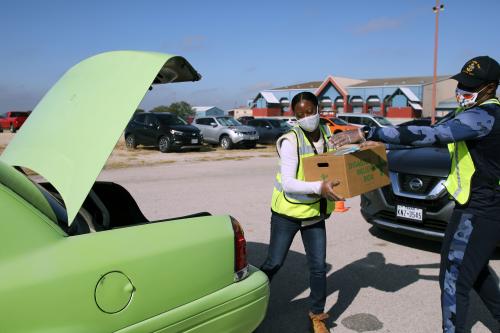When Franklin Roosevelt became president in 1933, he inherited a job market racked by collapsing demand and exploitative middlemen. Then, like now, unprecedented federal stimulus tackled demand. But FDR’s solution to the middlemen problem was very different. Today, the “Uberization” of work has spurred that problem once more, suggesting we need to update FDR’s solution and establish a public option for gig economy workers to find good work.
In the 1930s, thousands of employment agencies connected job seekers with jobs. But as economic desperation deepened during the Great Depression, those agencies developed scams such as charging for lists of fake openings.
Sadly, monetizing the desperation of job seekers has once again become a highly profitable business model. As certain kinds of jobs disappear, millions have turned to gig platforms such as Uber and DoorDash for work. And that’s a problem: Investigations of Uber have caught them slashing workers’ earnings, misleading job seekers, interfering with competitors, and systematically deceiving regulators. Research makes clear that Uber is far from an outlier.
Gig work isn’t just on the margins of our economy anymore. By 2018, over 35% of American workers were dependent on at least some ad-hoc employment. Many had medical needs, caregiving, school, or other demands that fluctuated day to day. That figure could reach 50% in the pandemic’s upended labor market. And the equity implications are huge: While a broad cross-section of workers participates in the gig economy, women and people of color are much more likely to do the lowest paid, least flexible, most exploitative types of work.
The Uber model is being emulated by thousands of platforms in sectors from cleaning to warehouse work to construction. Alongside the gig economy, algorithmic scheduling software is minimizing labor costs by deploying staff hour by hour, in line with employers’ ever-changing needs. In other words, more and more work is like gig work, even where workers are still technically employees.
How have policymakers responded? California led with a 2019 bill that forced platforms to provide basic protections for workers. Uber immediately announced it was exempt, then refused to comply. Then gig platform companies spent $205 million to successfully overturn the bill at the ballot box in November. The policy they backed, Proposition 22, took away critical workers’ rights and created an effective minimum wage researchers estimate at a meager $5.64 an hour.
As Bloomberg reported recently, this is triggering a broad race to the bottom: For instance, Albertsons, a major supermarket chain, is replacing its salaried truck drivers with DoorDash drivers.
Nearly a century ago, when FDR encountered his own problem with labor market profiteers, he found a solution by creating a public option for job seekers: Nationwide public labor exchanges that matched workers with jobs, established by the 1933 Wagner-Peyser Act. The exchanges still exist today, now branded as American Job Centers. Private staffing agencies professionalized over time and now work alongside the public system. As job searches moved online, states launched platforms to match job seekers with job openings and supplement commercial job boards.
Now, we need to adapt FDR’s public labor exchanges for the gig economy. There are trailblazers doing just that: A first wave of public agencies, led by the workforce board for Long Beach, Calif., are starting to launch their own platforms for finding gig work. This emergent service, which supports the core job training and matching missions of these agencies, comes without the high fees and pay controls that platform companies count on to produce big profits for their investors.
Beyond offering much fairer terms, a public option for gig work can support economic mobility too. At scale, local platforms can be horizontal, encompassing all types of work. Someone doing, say, cleaning work can prove reliability and attract training to then help fill a shortage of painters, then get a carpet-laying certificate to unlock even higher-paid work. This model of skilling is not the same as broad job retraining, which is often criticized. It can be personalized and data-driven, building stepping stones as a worker proves reliability and generates income for their next job pathway. Interventions can be tailored to support workers struggling along these nonstandard but critical career paths.
The core technology for these public exchanges is ready, thanks to a platform developed by Britain’s government and adapted for agencies here. Working with educators, nonprofits, employers, and other stakeholders, Long Beach’s CalFLEXI platform has just completed a successful, COVID-responsive pilot that allowed child care professionals seeking extra hours of work to provide flexible in-home care to essential workers.
But extending services to workers in nonstandard employment remains challenging for workforce agencies nationwide. They depend on federal workforce funding, which is tied to targets and data sources for traditional credentials and job retention—not more flexible, nonstandard work.
The Biden administration’s new Department of Labor (DOL) team could change that, starting with executive action. New metrics for rising earnings and personalized hours would incentivize local workforce agencies to create more choices in today’s fluid labor markets. DOL could start with a wave of pilots, learn more about what works, and scale from there. More flexible incentives and data tracking should also be incorporated into the reauthorization of federal workforce programs, which is on the agenda in Congress.
FDR discovered the need for a public option to match America’s workers with job demand on fair, nonexploitative terms. As the “Uberized” job market becomes the new normal for millions, we must address the same need. There’s no time to lose.








Commentary
Wanted: A public option for finding work in the gig economy
March 19, 2021